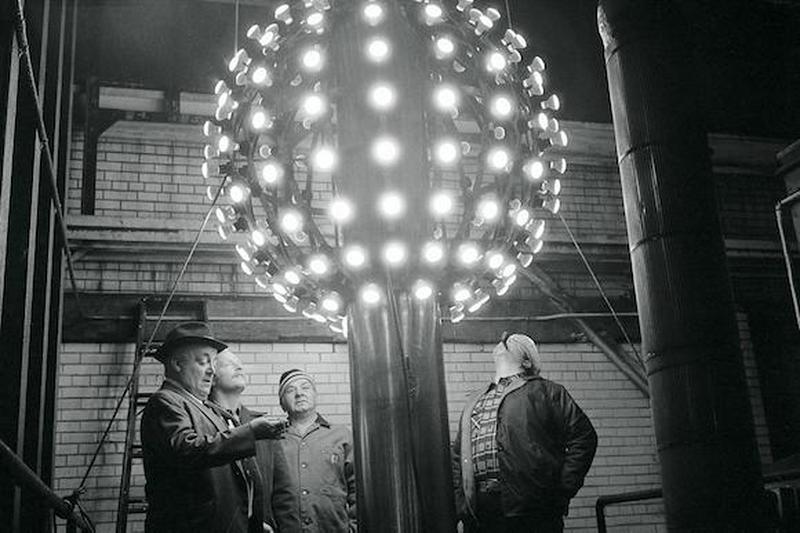Why Does The Times Square Ball Drop On New Year's Eve?
By | December 19, 2019
Time balls were phased out in the early 20th century
Americans have a lot of different ways of celebrating the new year. In some regions, people eat black eyed peas for good luck; those of us lucky enough to have a partner might get a kiss at midnight; and a full 100 million of us turn on the tube to watch the Times Square ball drop. When that famous orb completes its descent at midnight on New Year's Day, it signals the first moments of 365 days that we hope will be better than the last. But why? What does dropping a ball have to do with the new year?
Contrary to what you might think, using a falling sphere to demarcate time isn't just some arbitrary quirk of Dick Clark, that ageless sage of the new year. It's a tradition that harkens back to the sailing industry of the 19th century. The ball that drops every New Year's Eve in Times Square may be the most well-known time ball, but it's hardly the first. It's not even the only time ball in the Big Apple.

By the early 1900s, time was up for time balls. Clocks, watches, and time pieces of all sizes were a normal part of life, and watching a ball drop at specific time seemed quaint and outdated by comparison. However, a 1907 fireworks ban had the public crawling back to time balls for the annual New Year's Eve celebration held by The New York Times. Adolph Ochs, the owner of the Times, commissioned an illuminated, 700-lb. ball made of iron and wood to be lowered from the flagpole of the Times Tower at the start of the new year. Following the first ball drop, the paper reported:
The great shout that went up drowned out the whistles for a minute. The vocal power of the welcomers rose above even the horns and the cow bells and the rattles. Above all else came the wild human hullabaloo of noise.
Time balls were initially for nautical use

England's Portsmouth harbor is the birthplace of the time ball. In 1829, mariners who wanted to synch their chronometers used landmarks to estimate time, but on a foggy day or dark night, that wasn't always possible. To solve this problem, they started hoisting a large ball that could be seen by every ship in anchor at the harbor up a 15-ft. mast and then dropping it. The ball dropped daily at 1:00 P.M.
People loved watching time balls

Things on dry land were a little different. Before clocks and watches became affordable for regular Joes, people relied on a variety of means for telling time. The sundials that were used in most towns and church bells that rang every hour were good enough for citizens who spent all day performing a single task, but when sailors started using time balls, they became a major spectacle. People gathered around the time ball as early as 15 minutes before its drop just to watch it happen. To get even more of a thrill out of the ball drop, some of them brought time keepers to check the ball's accuracy.
America's first time ball wasn't very accurate

Time balls have never been incredibly precise, but the balls in Portsmouth and Greenwich got the job done as accurately as possible. When time balls made their way to America in 1845, the same couldn't be said for these initial attempts at time balling. That year, the first American time ball was constructed on top of the United States Naval Observatory in Washington, D.C.
The American time ball was a bit more complicated than its predecessors, which made it far less accurate. When it was time for this ball to drop, instead of just raising it up the mast like previous time balls, someone had to yell for ball to be put into motion, and then someone else tossed it on top of the Observatory's dome to roll to the roof below. It's unclear how the U.S. Secretary of the Navy decided on this method, but at the time, everyone was fairly happy with it. Sure, it dropped at wildly different times every day, but people generally didn't have high expectations of technology in the 19th century.
Between 1845 and 1902, time balls were placed around America, and while they drew the attention of crowds, they remained pretty bad at telling time. Alexis McCrossen, author of Marking Modern Times: A History of Clocks, Watches, and Other Timekeepers in American Life, said of these early American time balls:
They were constantly malfunctioning. They were dropping at the wrong time; a notice would be put in the newspaper to indicate the ball was erroneously dropped before or even after noon. They were covered in canvas, so on a windy day or a day when it was raining, the [method] didn't work.
The New Year’s Eve time ball isn’t a real time ball

You'd be hard-pressed to find a time ball outside of Times Square these days, and the ball that drops in Times Square every year doesn't even tell time the same way as traditional time balls. Actual time balls (like the one that you can still see in Greenwich, England) start dropping at the designated time, while the Times Square ball drops some seconds before, signaling the time at the end of its motion. We count down from 10, and when it lands, we're in a new year. This is an incredibly inaccurate way to tell time, but it is fun.

